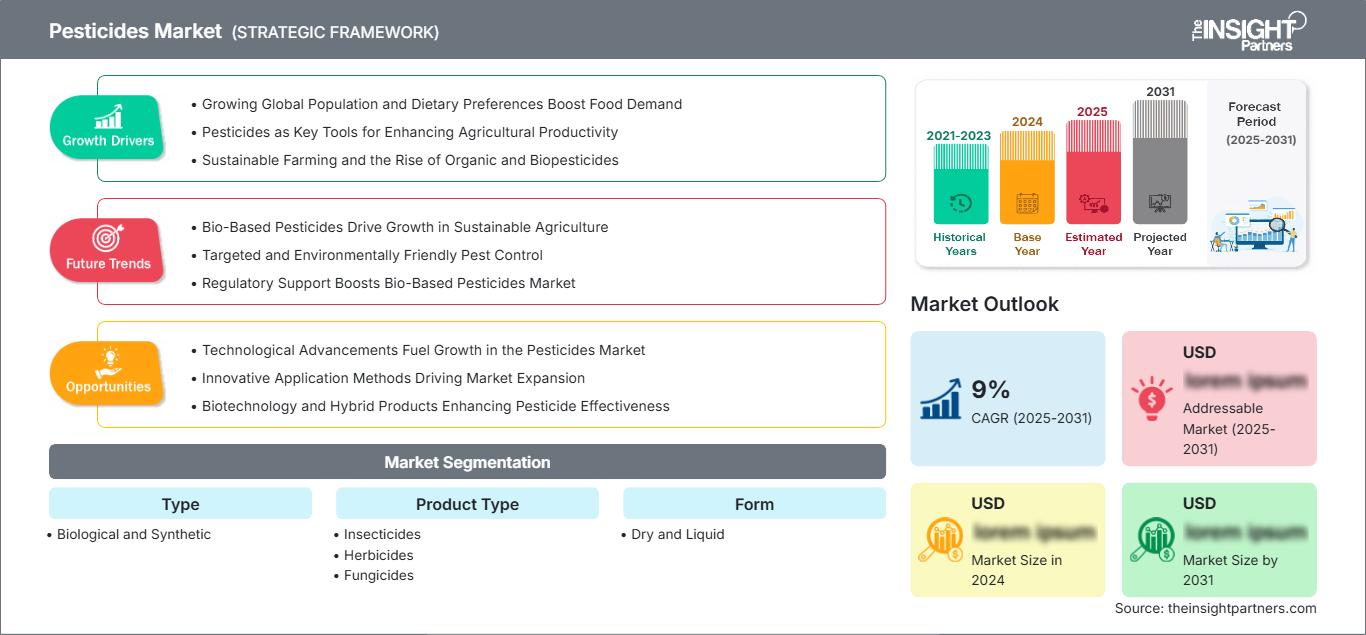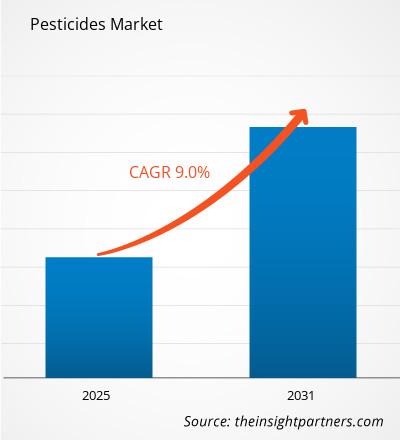Der Pestizidmarkt wird voraussichtlich zwischen 2025 und 2031 eine durchschnittliche jährliche Wachstumsrate (CAGR) von 9 % verzeichnen, wobei die Marktgröße von XX Millionen US-Dollar im Jahr 2024 auf XX Millionen US-Dollar im Jahr 2031 anwachsen wird.
Der Bericht präsentiert eine Analyse nach Typ (biologisch und synthetisch). Der Bericht ist nach Produkttyp (Insektizide, Herbizide, Fungizide und andere) segmentiert. Der Bericht ist nach Form (trocken und flüssig) segmentiert. Der Bericht ist nach Anwendungsart (Saatgutbehandlung, Bodenbehandlung, Blattspray und andere) segmentiert. Die globale Analyse ist weiter auf regionaler Ebene und nach wichtigen Ländern aufgeschlüsselt. In diesem Rahmen werden die Marktgröße und -prognose auf globaler, regionaler und Länderebene für alle wichtigen Marktsegmente abgedeckt. Der Bericht bietet den Wert in USD für die oben genannte Analyse und Segmente. Der Bericht enthält wichtige Statistiken zum Marktstatus der wichtigsten Marktteilnehmer und bietet Markttrends und -chancen.
Zweck des Berichts
Der Bericht „Pesticides Market“ von The Insight Partners beschreibt die aktuelle Situation und das zukünftige Wachstum sowie die wichtigsten treibenden Faktoren, Herausforderungen und Chancen. Dadurch erhalten verschiedene Geschäftsinteressenten Einblicke, wie z. B.:
- Technologieanbieter/-hersteller: Um die sich entwickelnde Marktdynamik zu verstehen und die potenziellen Wachstumschancen zu erkennen, damit sie fundierte strategische Entscheidungen treffen können.
- Investoren: Um eine umfassende Trendanalyse hinsichtlich der Marktwachstumsrate, der finanziellen Marktprognosen und der Chancen entlang der Wertschöpfungskette durchzuführen.
- Regulierungsbehörden: Um Richtlinien und Überwachungsaktivitäten auf dem Markt zu regulieren, mit dem Ziel, Missbrauch zu minimieren, das Vertrauen der Investoren zu wahren und die Integrität und Stabilität des Marktes aufrechtzuerhalten.
Pestizide Marktsegmentierung Typ
- Biologische und synthetische
Produkttyp
- Insektizide
- Herbizide
- Fungizide
- Sonstige
Form
- Trocken und flüssig
Geographie
- Nordamerika
- Europa
- Asien-Pazifik
- Süd- und Mittelamerika
- Naher Osten und Afrika
Sie erhalten kostenlos Anpassungen an jedem Bericht, einschließlich Teilen dieses Berichts oder einer Analyse auf Länderebene, eines Excel-Datenpakets sowie tolle Angebote und Rabatte für Start-ups und Universitäten.
Pestizidmarkt: Strategische Einblicke

-
Holen Sie sich die wichtigsten Markttrends aus diesem Bericht.Dieses KOSTENLOSE Beispiel umfasst Datenanalysen, die von Markttrends bis hin zu Schätzungen und Prognosen reichen.
Wachstumstreiber im Pestizidmarkt
- Wachsende Weltbevölkerung und Ernährungspräferenzen steigern die Nachfrage nach Nahrungsmitteln: Das Wachstum der Weltbevölkerung und die Zunahme der Ernährungspräferenzen erhöhen die Nachfrage nach Nahrungsmitteln. Immer mehr Menschen suchen nach nahrhaften und abwechslungsreichen Nahrungsmitteloptionen, und die landwirtschaftliche Produktion muss weiter gesteigert werden, um diesen Bedarf zu decken. Der steigende Bedarf an Nahrungsmitteln zwingt Landwirte, ihre Ernteerträge zu steigern, was weitgehend von landwirtschaftlichen Betriebsmitteln wie Pestiziden abhängt, um die Pflanzen vor Schädlingen und Krankheiten zu schützen.
- Pestizide als Schlüsselinstrumente zur Steigerung der landwirtschaftlichen Produktivität: Pestizide sind die wichtigsten Instrumente zur Steigerung der landwirtschaftlichen Produktivität. Durch die Verringerung der Risiken durch Insekten, Unkraut und Krankheitserreger können Nutzpflanzen potenziell auf ein höheres Produktivitätsniveau gebracht werden. Dieser Bedarf an Effizienzsteigerungen in der Nahrungsmittelproduktion treibt Landwirte zu immer fortschrittlicheren Pestizidformulierungen und -technologien, die das Marktwachstum weiter ankurbeln.
- Nachhaltige Landwirtschaft und der Aufstieg von Bio- und Biopestiziden: Nachhaltige Landwirtschaft revolutioniert auch die Welt der Pestizide. Die Nachfrage nach Bio-Pestiziden, die den Ertrag steigern, ohne die Umwelt nennenswert zu belasten, steigt täglich. Sowohl der integrierte Schädlingsbekämpfungsansatz als auch Biopestizide erfreuen sich großer Nachfrage, da Verbraucher gesündere Lebensmittel benötigen und Regierungen die Reduzierung von Chemikalien in der Landwirtschaft fordern.
Zukünftige Trends im Pestizidmarkt
- Biobasierte Pestizide treiben das Wachstum in der nachhaltigen Landwirtschaft: Biobasierte Pestizide, deren Wachstum durch die Nachfrage nach nachhaltiger Landwirtschaft vorangetrieben wird, haben sich zu einem der wichtigsten Trends auf dem Pestizidmarkt entwickelt. Biobasierte Pestizide sind sicherer als synthetische Chemikalien und werden aus natürlichen Quellen gewonnen. Verbraucher werden immer gesundheitsbewusster und bevorzugen daher biologische oder umweltfreundliche Anbaumethoden, was zu einer verstärkten Nutzung biobasierter Lösungen führt.
- Gezielte und umweltfreundliche Schädlingsbekämpfung: Biobasierte Pestizide entwickeln sich zu potenziellen Produkten für Landwirte, da sie die Eigenschaften effektiver Schädlingsbekämpfungsmittel besitzen. Solche Produkte bekämpfen gezielt Schädlinge und schädigen Nützlingspopulationen sowie die Umwelt nur minimal. Forschung und Entwicklung erweitern die Palette an Optionen, die zunehmend für verschiedene Kulturen und Betriebsarten praktisch anwendbar sind.
- Regulatorische Unterstützung stärkt den Markt für biobasierte Pestizide: Dieser Wandel wird auch von den Regulierungsbehörden unterstützt, da sie Richtlinien und Leitlinien zur Förderung biobasierter Pestizide entwickeln. Zweifellos hat sich die Beschränkung der Anwendung chemischer Pestizide positiv für die Landwirte ausgewirkt, da sie nun gezwungen sind, auf Bio-Pestizide umzusteigen. Auch die regulatorische Unterstützung stimuliert die Markterweiterung, dennoch ist die Entwicklung effizienterer und effektiverer Produkte im Markt für Biopestizide willkommen.
Marktchancen für Pestizide
- Technologische Fortschritte treiben das Wachstum im Pestizidmarkt an: Fortschritte in der Technologieintegration bieten zahlreiche Wachstumschancen im Pestizidmarkt. Fortschrittlichste Agrartechnologien wie Präzisionslandwirtschaft und Datenanalyse ermöglichen es Landwirten, Pestizide gezielt einzusetzen und so optimale Ergebnisse zu erzielen. Dadurch wird der Chemikalieneinsatz reduziert und ein maximaler Pflanzenschutz gewährleistet, was zu einem Marktwachstum geführt hat.
- Innovative Anwendungsmethoden treiben das Marktwachstum voran: Die Anwendungstechnologie für Pestizide wurde durch die Erfindung von Drohnen und automatischen Sprühgeräten revolutioniert. Solche Geräte zielen präzise und gleichmäßiger, wodurch Verluste minimiert und die Wirksamkeit der Behandlung optimiert wird. Da solche Werkzeuge zunehmend von Landwirten eingesetzt werden, wird die Nachfrage nach verbesserten Pestizidformulierungen, die durch solche Technologien effektiv eingesetzt werden können, steigen und so das Marktwachstum weiter vorantreiben.
- Biotechnologie und Hybridprodukte steigern die Wirksamkeit von Pestiziden: Der Pestizidmarkt wird vom Wachstum der Biotechnologie beeinflusst, und in diesem Zusammenhang werden GVO, Biopestizide und andere Produkte entwickelt, die synergetisch mit herkömmlichen Pestiziden wirken. Diese Integration eröffnet neue Möglichkeiten für Hybridprodukte, die die Schädlingsresistenz und die Widerstandsfähigkeit von Nutzpflanzen verbessern, damit Landwirte effektivere Lösungen erzielen können.
Regionale Einblicke in den Pestizidmarkt
Die Analysten von The Insight Partners haben die regionalen Trends und Faktoren, die den Pestizidmarkt im Prognosezeitraum beeinflussen, ausführlich erläutert. In diesem Abschnitt werden auch die Marktsegmente und die geografische Lage in Nordamerika, Europa, dem asiatisch-pazifischen Raum, dem Nahen Osten und Afrika sowie Süd- und Mittelamerika erörtert.
Umfang des Marktberichts zu Pestiziden
| Berichtsattribut | Einzelheiten |
|---|---|
| Marktgröße in 2024 | US$ XX million |
| Marktgröße nach 2031 | US$ XX Million |
| Globale CAGR (2025 - 2031) | 9% |
| Historische Daten | 2021-2023 |
| Prognosezeitraum | 2025-2031 |
| Abgedeckte Segmente |
By Typ
|
| Abgedeckte Regionen und Länder |
Nordamerika
|
| Marktführer und wichtige Unternehmensprofile |
|
Dichte der Akteure auf dem Pestizidmarkt: Verständnis ihrer Auswirkungen auf die Geschäftsdynamik
Der Pestizidmarkt wächst rasant, angetrieben durch die steigende Endverbrauchernachfrage aufgrund von Faktoren wie sich entwickelnden Verbraucherpräferenzen, technologischem Fortschritt und einem stärkeren Bewusstsein für die Produktvorteile. Mit steigender Nachfrage erweitern Unternehmen ihr Angebot, entwickeln Innovationen, um den Verbraucherbedürfnissen gerecht zu werden, und nutzen neue Trends, was das Marktwachstum weiter ankurbelt.

- Holen Sie sich die Pestizidmarkt Übersicht der wichtigsten Akteure
Wichtige Verkaufsargumente
- Umfassende Abdeckung: Der Bericht analysiert umfassend Produkte, Dienstleistungen, Typen und Endnutzer des Pestizidmarkts und bietet einen ganzheitlichen Überblick.
- Expertenanalyse: Der Bericht basiert auf dem umfassenden Verständnis von Branchenexperten und Analysten.
- Aktuelle Informationen: Der Bericht gewährleistet Geschäftsrelevanz durch die Berichterstattung über aktuelle Informationen und Datentrends.
- Anpassungsoptionen: Dieser Bericht kann an spezifische Kundenanforderungen angepasst werden und passt sich so optimal an die Geschäftsstrategien an.
Der Forschungsbericht zum Pestizidmarkt kann daher dabei helfen, die Branchensituation und die Wachstumsaussichten zu entschlüsseln und zu verstehen. Obwohl es einige berechtigte Bedenken geben mag, überwiegen die Vorteile dieses Berichts tendenziell die Nachteile.
- Historische Analyse (2 Jahre), Basisjahr, Prognose (7 Jahre) mit CAGR
- PEST- und SWOT-Analyse
- Marktgröße Wert/Volumen – Global, Regional, Land
- Branchen- und Wettbewerbslandschaft
- Excel-Datensatz
Aktuelle Berichte
Erfahrungsberichte
Grund zum Kauf
- Fundierte Entscheidungsfindung
- Marktdynamik verstehen
- Wettbewerbsanalyse
- Kundeneinblicke
- Marktprognosen
- Risikominimierung
- Strategische Planung
- Investitionsbegründung
- Identifizierung neuer Märkte
- Verbesserung von Marketingstrategien
- Steigerung der Betriebseffizienz
- Anpassung an regulatorische Trends






















 Kostenlose Probe anfordern für - Pestizidmarkt
Kostenlose Probe anfordern für - Pestizidmarkt